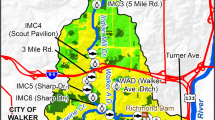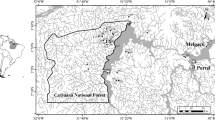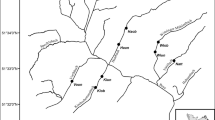Abstract
The use of nature areas as an effective tool for conservation of streams and their biota is a relatively unexplored option in urban stream management. Benthic macroinvertebrates and water quality in an urban stream, Poplar Creek, were monitored along a continuum within and downstream of a forest preserve in the western Chicago metropolitan area, USA. Taxa richness and a benthic macroinvertebrate index of biological integrity (MIBI) increased as the stream progressed within the preserve, but percentage of Ephemeroptera, Trichoptera, and Plecoptera (%EPT) showed no improvement. Reductions in the amount of silt substrates and increases in gravel-dominated substrate were evident at sites within the preserve. There were no improvements in water-quality measures tested although trends may have been obscured by precipitation events between sampling occasions. The benefits in stream quality attained within the forest preserve extended beyond the downstream border of the preserve and were not diminished by the presence of a railway, which bisected the stream. The nature preserve provided an opportunity for increased macroinvertebrate biodiversity, likely through local reductions in impervious surfaces and improvements in stream substrate, despite lack of evidence that it improved water quality.




Similar content being viewed by others
References
Allan JD (2004) Landscapes and riverscapes: the influence of land use on stream ecosystems. Annu Rev Ecol Syst 35:257–284
Anbumozhi V, Radhakrishnan J, Yamaji E (2004) Impact of riparian buffer zones on water quality and associated management considerations. Ecol Eng 24:517–523
APHA (1998) Standard methods for the examination of water and wasterwater, 20th edn. American Public Health Association, Washington
Barbour MT, Graves CG, Plafkin JL, Wisseman RW, Bradley BP (1992) Evaluation of EPA’s rapid bioassessment benthic metrics: metric redundancy and variability among reference stream sites. Environ Toxicol Chem 11:437–449
Barton K (2012) MuMIn: model selection and model averaging based on information criteria. R package version 1.7.7. R Project for Statistical Computing, Vienna
Bernhardt ES, Palmer MA (2007) Restoring streams in an urbanizing world. Freshw Biol 52:738–751
Booth DB, Jackson CR (1997) Urbanization and aquatic systems: degradation thresholds, stormwater detection, and the limits of mitigation. J Am Water Resour Assoc 33:311–323
Brenden TO, Wang L, Seelbach PW, Clark RD, Wiley MJ, Sparks-Jackson BL (2006) A spatially constrained clustering program for river valley segment delineation from GIS digital river networks. Environ Model Softw 23:638–649
Burnham KP, Anderson DR (2002) Model selection and multimodal inference: a practical informationtheoretic approach. Second edition. Springer, New York
Cao Y, Hawkins CP (2011) The comparability of bioassessments: a review of conceptual and methodological issues. J N Am Benthol Soc 30:680–701
Cao Y, Price-Stodola A, Douglass S, Shasteen D, Cummings K, Holtrop A (2015) Modeling and mapping the distributions of mussel species, species diversity, and total abundance in wadeable streams of Illinois, USA. Freshw Biol. doi:10.1111/fwb.12575
Clarke KR, Gorely RN (2006) PRIMER v6: user manual/tutorial. PRIMER-E, Plymouth
Cuffney TE, Bilger MD, Haigler AM (2007) Ambiguous taxa: efforts on the characterization and interpretation of macroinvertebrate assemblages. J N Am Benthol Soc 26:286–307
Dunne T, Leopold LB (1978) Water in environmental planning. Freeman, New York
Groffman PM, Bain DJ, Boulware NJ, Zipperer WC, Pouyat RV, Band LET, Colosimo MF (2002) Soil nitrogen cycle processes in urban riparian zones. Environ Sci Technol 36:4547–4552
Guisan A, Edwards TC, Hastie T (2002) Generalized linear and generalized additive models in studies of species distributions: setting the scene. Ecol Model 157:89–100
Harding JS, Claassen K, Evers N (2006) Can forest fragments reset physical and water quality conditions in act as refugia for forest stream invertebrates? Hydrobiologia 568:391–402
Harper D, Ebrahimnexhad M, Climent I, Cot F (1998) Artificial rifles in river rehabilitation: setting the goals and measuring the successes. Aquat Conserv Mar Freshwat Ecosyst 8:5–16
Houghton DC, Berry EA, Gilchrist A, Thompson A, Nussbaum MA (2011) Biological changes along the continuum of an agricultural stream: influence of a small terrestrial preserve and use of adult caddisflies in biomonitoring. J Freshw Ecol 26:381–397
Hawkins C, Ostermiller J, Vinson M, Stevenson RJ, Olson J (2003) Stream algae, invertebrate, and environmental sampling associated with biological water quality assessments. Department of Aquatic, Watershed, and Earth Resources, Western Center for Monitoring and Assessment of Freshwater Ecosystems, Utah State University, Logan, Utah
Hynes HBN (1975) The stream and its valley. Verh Int Ver Theor Angew Limnol 19:1–15
IEPA (2003) Quality assurance and field methods manual. IEPA, Division of Water Pollution Control, IL Envronmental Protection Agency, Springfield
IEPA (2004) Illinois benthic macroinvertebrate collection method comparison and stream condition index revision. Prepared by Tetra-Tech, Inc for Illinois Department of Environmental Protection, Springfield, IL
King RS, Nunnery KT, Richardson CJ (2000) Macroinvertebrate assemblage response to highway crossings in forested wetlands: implications for biological assessment. Wetl Ecol Manag 8:243–256
Meals DW, Dressing SA, Davenport TE (2010) Lag time in water quality response to best management practices: a review. J Environ Qual 39:85–96
Meyer JL, Paul MJ, Taulbee WK (2005) Stream ecosystem function in urbanizing landscape. J N Am Benthol Soc 24:602–612
Moore AA, Palmer MA (2005) Invertebrate biodiversity in agricultural and urban headwater streams: implications for conservation and management. Ecol Appl 15:1169–1177
Oberndorfer E, Lundholm J, Bass B, Coffman RR, Doshi H, Dunnett N, Gaffin S, Köhler M, Liu KKY, Rowe B (2007) Green roofs as urban ecosystems: ecological structures, functions, and services. Bioscience 57:823–833
Oksanen J, Blanchet G, Kindt R, Legendre P, Minch PR, O’Hara RB, Simpson GL, Solymos P, Stevens HH, Wagner H (2012) VEGAN: community ecology package. R package version 2.0-3. R Project for Statistical Computing, Vienna
Palmer MA, Hakenkamp CC, Nelson-Baker K (1997) Ecological heterogeneity in streams: why variance matters. J N Am Benthol Soc 16:189–202
Palmer MA, Menninger HL, Bernhardt E (2010) River restoration, habitat heterogeneity and biodiversity: a failure of theory or practice? Freshw Biol 55:205–222
Palmer MA, Hondula KL, Koch BJ (2014) Ecological restoration of streams and rivers: shifting strategies and shifting goals. Annu Rev Ecol Evol Syst 45:247–269
Paul MJ, Meyer JL (2001) Streams in the urban landscape. Annu Rev Ecol Evol Syst 32:333–365
R Development Core Team (2011) R: a language and environment for statistical computing. Vienna, Austria: R Foundation for statistical computing (http://www.R-project.org)
Rankin ET (1989) The Qualitative Habitat Evaluation Index (QHEI): rationale, methods, and application. Ohio Environmental Protection Agency, Ecological Assessment Section, Division of Water Quality and Assessments, Columbus
Scarsbrook MR, Halliday J (1999) Transition from pasture to native forest landuse along stream continua: effects on stream ecosystems and implications for restoration. N Z J Mar Freshw Res 33:293–310
Storey RG, Cowley DR (1997) Recovery of three New Zealand rural streams as they pass through native forest remnants. Hydrobiologia 353:63–67
Sudduth EB, Meyer JL (2006) Effects of bioengineering on bank habitat and macroinvertebrates in urban streams. Environ Manag 38:218–226
USDA (1986) Technical release-55: urban hydrology for small watersheds (http://www.nrcs.usda.gov/Internet/FSE_DOCUMENTS/stelprdb1042897.pdf)
Vannote RL, Minshall GW, Cummins KW, Sedell JR, Cushing CE (1980) The river continuum concept. Can J Fish Aquat Sci 37:130–137
Walsh CJ, Leonard AW, Lardson AR, Fletcher TD (2004) Urban stormwater and the ecology of streams. CRC for Freshwater Ecology and CRC for Catchment Hydrology, Canberra
Walsh CJ, Fletcher TD, Ladson AR (2005) Stream restoration in urban catchments through redesigning stormwater systems: looking to the catchment to save the stream. J N Am Benthol Soc 24:690–705
Wang L, Lyons J, Kanehl P, Gatti R (1997) Influence of watershed land use on habitat quality and biotic integrity in Wisconsin streams. Fisheries 22:6–12
Wang L, Lyons J, Kanehl P (2001) Impacts of urbanization on stream habitat and fish across multiple spatial scales. Environ Manag 28:255–266
Wang L, Brenden T, Cao Y, Seelbach P (2011) Delineation and validation of river network spatial scales for water resources and fisheries management. Environ Manag 50:875–887
Ward JV (1998) Riverine landscapes: biodiversity patterns, disturbance regimes, and aquatic conservation. Freshw Biol 47:517–539
Warrner SS, Fischer RU, Holtrop AM, Hinz LC Jr, Novak JM (2010) Evaluating the Illinois stream valley segment model as an effective management tool. Environ Manag 46:761–770
Weins JA (1989) Spatial scaling in ecology. Funct Ecol 3:385–397
Acknowledgments
We thank the Cook County Forest Preserve District for allowing us access to the Poplar Creek Forest Preserve. Funding for this study was provided by the Canadian National Railroad.
Author information
Authors and Affiliations
Corresponding author
Rights and permissions
About this article
Cite this article
Wilkins, P.M., Cao, Y., Heske, E.J. et al. Influence of a forest preserve on aquatic macroinvertebrates, habitat quality, and water quality in an urban stream. Urban Ecosyst 18, 989–1006 (2015). https://doi.org/10.1007/s11252-015-0464-6
Published:
Issue Date:
DOI: https://doi.org/10.1007/s11252-015-0464-6




